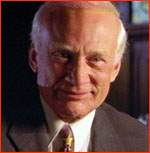
|
 |
 |
Buzz Aldrin flew on Gemini 12 and Apollo 11. With Neil Armstrong, he made the first human landing on the moon on July 20, 1969. On Apollo 11: "So it surprised me that during that time, Neil chose to make the call to Houston Tranquility Base that the Eagle has landed." As soon as we touched down, I knew we'd done it, but I knew that there were certain discrete times after the nominal touchdown, if something was wrong, you don't want to abort right away, you want to wait until this discrete time, because there are more favorable rendezvous conditions. After about two minutes, then it's too late really, because if you were to lift off after two minutes after the normal landing, Mike Collins is going around and around and he's too far ahead for you to catch up to him in a reasonable time, and he's going to have to do some other maneuvers so that you can catch up with him. So those first couple of minutes are very crucial to look around and see if everything is okay and hope that the Earth is measuring everything of the status of all your pressure systems, and your tanks, and your electrical systems, because if you do have to abort, you should do it right away. And I felt that that was a fairly critical time, so it surprised me that during that time, Neil chose to make the call to Houston Tranquility Base that the Eagle has landed. It surprised me a little bit, because we never trained to do that, because we didn't want to tell them back in the simulators in the training what we were going to say after we landed, and I expected he would wait until we'd been there [and] that we could monitor those things. But it's something that is a surprise, but then you understand—well, that's the way you should do it; you should call right away, things like that. On Apollo 11: "Well, the first thing that I wanted to do when I got on the surface was to hold on and to just sort of bounce around."
Back to Hear the Space Pioneers Photo: NASA Explore the Moon | Lunar Puzzlers | Last Man on the Moon Hear the Space Pioneers | Origins | Resources Transcript | Site Map | To the Moon Home Editor's Picks | Previous Sites | Join Us/E-mail | TV/Web Schedule About NOVA | Teachers | Site Map | Shop | Jobs | Search | To print PBS Online | NOVA Online | WGBH © | Updated November 2000 |
 Buzz Aldrin
Buzz Aldrin